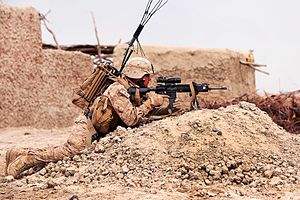
A US Marine automatic rifleman armed with an M27 fitted with a Harris bipod and a 3.5x SAW Day Optic provides security for his team in Afghanistan in March 2012.
The M27 Infantry Automatic Rifle (IAR) is a lightweight, magazine-fed 5.56mm weapon used by the United States Marine Corps, which is intended to enhance an automatic rifleman's maneuverability and displacement speed, based on the HK416. The US Marine Corps has purchased 6,500 IARs to replace a portion of the M249 Squad Automatic Weapons currently employed by automatic riflemen within Infantry and Light Armored Reconnaissance Battalions. Approximately 8,000-10,000 M249s will remain in service in serice at the company level to be used at the discretion of company commanders. The United States Army does not plan to purchase the IAR.
History[]

M27 displayed at the NDIA Joint Armaments Conference in May 2010.
The Infantry Automatic Rifle program began in 2005, when the Marine Corps sought information from manufacturers. In 2006, Contracts were issued for sample eapons to Fabrique Nationale d'Herstal, H&K and Colt Defense, which provided two competing designs. Companies that attempted to compete but were not accepted as finalists for testing include Land Warfare Resources Corporation, whihc competed with the M6A4 IAR, Patriot Ordnance Factory, and General Dynamic Armament and Technical Products with the CIS Ultimax 100 MK5. In December 2009, the HK model beat out the other three finalists, and had entered the final five months of testing. It was designated as the M27 in the summer of 2010, coincidentially sharing a designation with the M27 link it would not use, but instead it was named after 2nd Battalion, 7th Marines who were testing with automatic rifles since before 11 September 2001.
While Marine Corps Systems Command was optimistic about operational testing, former Commandant of the Marine Corps General James T. Conway remained skeptical that the reduced firepower at the fireteam-level was a viable option. After the Marine Corps Operational Test and Evaluation Activity supervised a round of testing at MCAGCC Twentynine Palms, Fort McCoy, and Camp Shelby, limited fielding began for 458 IARs to four infantry battalions and one light armored reconnaissance battalion; all of which deployed to Afghanistan in 2011.
In May 2011, General James Amos of the Marine Corps approved the termination of a Limited User Evaluation, and the replacement of the M249 LMG by the M27. Fielding of the approximately 6,500 M27 units is expected to complete in summer 2013, for a cost of $13 million. M27 gunners will be equippede with around 22 of the 30-round magazines already in use with the M16 and M4 Carbine. Twenty-two magazines will approximate the perscribed individual combat load of an M249 SAW gunner, and although the M27 gunner is not expected to carry all 22 magazines, they are provided to the units so that a determination can be made at the unit level on what the individual combat load should look like. It will undoubtedly vary by unit, based on the evaluations conducted by the four infantry battalion and one light armored reconnaissance battalion that were issued quantities of the M27 for the LUE. Though program officials are aware that switching from the belt-fed M249 will result in a loss of suppressive fire capabilities, Charles Clark III, of the Marine Corps' Combat Development and Integration office cites the substantially increased accuracy of the M27 as a significant factor in replacing the M249.
The notion that the M27 represents a reduction in suppressive fire has spawned considerable debate among proponents of the M249 SAW within the infantry, and those who advocate that a lighter, more maneuverable, and accurate weapon is sufficient to support offensive operations at the squad level. It is debatable, in fact, that program officials actually concede a loss of suppressive fire capabilities, as the only statements of concern over this concept were made by General Conway.
Beyond the increased accuracy, another proposed benefit of the M27 over the M249 is that it is, in many respects, a modified M4 rifle as used by the rest of the squad. This makes it far more suitable for operating indoors and in other cramped situations where its reduced size and weight make it faster and easier to handle. Although not ideal for close quarters fighting, it is far better in this function than the M249.
Combat reviews[]
Marines issued with the M27 enjoy its familiarity with the M4-style weapons in service. It is more friendly to troops due to fewer moving parts, fewer jams, and a cleaner operating system. IAR gunners consider the rifle-grade accuracy to be a huge improvement over teh SAW; despite the loss of sustained firing. With a shrinking budget, the Marine Corps is looking at ways to implement the IAR as a multipurpose weapon. Suggestions include use as an automatic rifle and as a designated marksman rifle.